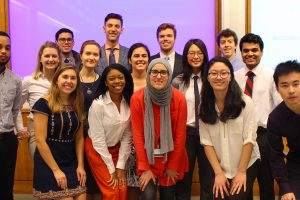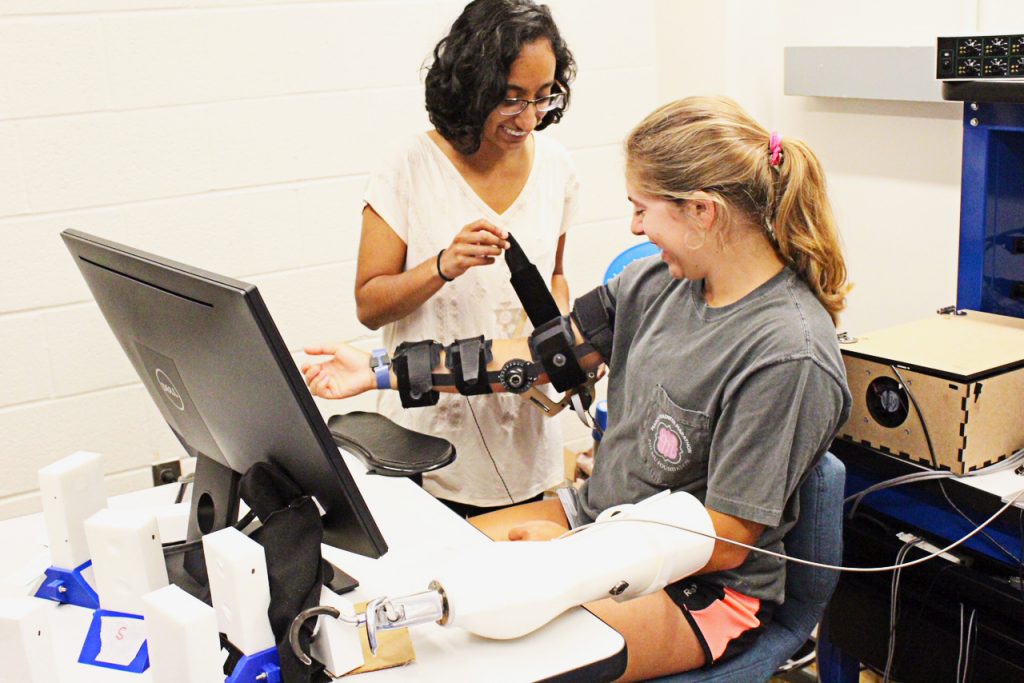
Forget the pool. This summer, a group of talented undergraduates from universities nationwide dove headfirst into exciting research projects in labs across the Homewood campus as part of the National Science Foundation’s Research Experiences for Undergraduates (REU) Program in Computational Sensing and Medical Robotics (CSMR).
Through this immersive, 10-week program, 14 undergraduate students – some from local colleges and others from as far away as Texas and Utah – got the chance to work on cutting-edge research under the guidance of graduate student mentors and Hopkins faculty members from the electrical and computer engineering, mechanical engineering, computer science, and biomedical engineering departments.
At a poster session held on August 2 in Hodson Hall, the students exhibited the results of their research.
Projects showcased a range of research, from bio-inspired robots and new remotely operated underwater vehicles to machine learning techniques to detect seizures, investigations into the sensing behavior in electric fish, and novel approaches to data collection and analysis.
Colette McGarvey spent her summer working closely with Neha Thomas, a PhD student in biomedical engineering, in the laboratory of Jeremy Brown, John C. Malone Assistant Professor of Mechanical Engineering. McGarvey studied ways in which haptic feedback can be incorporated into prosthetics to improve the quality of life for those living with limb loss. A biomedical engineering major from Tulane University, McGarvey said that working as a member of a Hopkins research team exposed her to new possibilities in the engineering field.

CSMR REU student Colette McGarvey and graduate mentor Neha Thomas working in the lab (Image credit: Senesie Soko)
“I was very involved in all parts of the project and I really enjoyed working with human subjects,” said McGarvey. “I’ve never worked with prosthetics or haptics before this summer, so it’s been exciting to learn about a whole new area of research.”
Kelly Kempski, a rising senior at University of Delaware, devoted her summer to research in the Photoacoustic and Ultrasonic Systems Engineering (PULSE) Lab led by Muyinatu Bell, assistant professor of electrical and computer engineering. According to Bell, students are not the only ones who gain from the experience.
“Kelley integrated seamlessly into my lab and became a valuable member of our team this summer. She led a project that I’ve always thought about but did not have manpower to initiate prior to her arrival. I enjoy working with the CSMR REU students each summer – they always bring a fresh perspective to my research ideas,” said Bell.
Over several weeks, Kempski worked on an in-vivo photoacoustic imaging system to improve visualization of blood vessels during pancreatic and liver surgery, an approach that could reduce blood loss and ultimately improve surgical outcomes.
“I’ve always been interested in medical imaging. The CSMR REU program was a great opportunity to work with leaders in that field and gain hands-on experience in a surgical setting,” said Kempski. “The best part was that I had plenty of one-on-one interactions with Professor Bell. She asked the tough questions that I needed to answer to learn the basics.”
Kempski won first place in the final poster competition, and was selected to present her work at the larger NSF REU Symposium in October. Brittany Nixon, a student from University of Maryland, College Park who worked with Noah Cowan, professor of mechanical engineering, came in second place with her project, titled “A Mathematical Model of the Fish Tracking Response of the Weakly Electric Glass Knifefish.” Additionally, several students shared that they plan to submit their research to peer-reviewed journals or upcoming conferences.
Learn more about all the 2018 CSMR REU projects here.